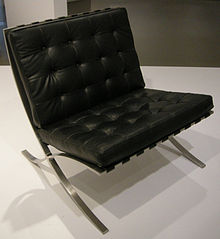Barcelona chair
 | |
| Designer | Ludwig Mies van der Rohe and Lilly Reich |
|---|---|
| Date | 1929 |
| Materials | Chrome on steel frame. Leather cushions filled with foam |
| Style / tradition | Modernist |
| Height | 75 cm (30 in) |
| Width | 75 cm (30 in) |
| Depth | 75 cm (30 in) |
The Barcelona chair is a chair designed by Ludwig Mies van der Rohe and Lilly Reich,[citation needed] for the German Pavilion at the International Exposition of 1929, hosted by Barcelona, Catalonia, Spain.
The chair was first used in Villa Tugendhat, a private residence, designed by Mies in Brno (Czech Republic).[1]
Materials and manufacture[]
The frame was initially designed to be bolted together, but was redesigned in 1950 using stainless steel, which allowed the frame to be formed by a seamless piece of metal, giving it a smoother appearance. Bovine leather replaced the ivory-colored pigskin which was used for the original pieces.
Philosophy and ergonomics[]
Although many architects and furniture designers of the Bauhaus era were intent on providing well-designed homes and impeccably manufactured furnishings for the "common man," the Barcelona chair was an exception. It was designed for the Spanish Royalty to oversee the opening ceremonies of the exhibition and described by Time magazine as inhabiting "his sumptuous German pavilion."[2] The form is thought to be extrapolated from Roman folding chairs known as the Curule chair – upholstered stools used by Roman aristocracy. According to Knoll Inc., despite its industrial appearance the Barcelona chair requires much hand craftsmanship.[3]
Current production[]
Since 1953 Knoll Inc has manufactured the Barcelona chair in both chrome and stainless steel. The chairs are almost completely hand-crafted,[3] and each carries a facsimile of van der Rohe's signature, stamped into its frame.
Barcelona chairs are made by other manufacturers worldwide and are sold under different marketing names.[citation needed]
In popular culture[]
In his 1981 book about modern architecture, From Bauhaus to Our House, Tom Wolfe called the Barcelona chair as "the Platonic ideal of chair", and wrote that, despite its high price, owning one had become a necessity for young architects: "When you saw the holy object on the sisal rug, you knew you were in a household where a fledgeling architect and his young wife had sacrificed everything to bring the symbol of the godly mission into their home."[4]
See also[]
- Barcelona Pavilion
- Bauhaus
- List of chairs
- List of furniture designers
- Ludwig Mies van der Rohe
- X-chair
References[]
- ^ Centre, UNESCO World Heritage. "Tugendhat Villa in Brno". UNESCO World Heritage Centre.
- ^ "Art: Architects' Furniture". February 18, 1957 – via content.time.com.
- ^ Jump up to: a b "Archived copy" (PDF). Archived from the original (PDF) on 2010-04-01. Retrieved 2010-04-14.CS1 maint: archived copy as title (link)
- ^ Goldberger, Paul (October 11, 1981). "From Bauhaus to Our House". The New York Times.
- Sourcebook of Modern Furniture, Third Edition, Jerryll Habegger and Joseph H Osman
- Miles van der Rohe, Aurora Cuito and Cristina Montes
- Bauhaus, Hans Engels and Ulf Meyer
- Modernism - designing a new world, Christopher Wilk, V&A p. 155
- Oxford Dictionary of Modern Design, Jonathan Woodham
External links[]
| Wikimedia Commons has media related to Barcelona chair. |
- Chairs
- Products introduced in 1921
- Individual models of furniture

